CHCECE001: Developing Cultural Competence Through Learning Experience
VerifiedAdded on 2023/06/18
|6
|1202
|129
Project
AI Summary
This project details a learning experience designed to foster cultural competence in children aged 1 to 6 years. The project outlines activities such as playing, creative expression through art and music, solving puzzles, investigating problems, and setting up stages, tailored to different age groups. It emphasizes the importance of resources like books, journals, and external agencies such as Child Australia, and strategies to promote cultural inclusion, including celebrating festivals and addressing cultural differences. The project also highlights opportunities for children to explore culture through interaction with diverse individuals and collaboration with stakeholders like parents and external organizations to enhance the learning experience. The document provides feedback mechanisms and advice to improve service delivery and ensure a better learning environment for children, focusing on cultural inclusion and effective interaction with diverse cultures. Desklib is a platform where students can find such solved assignments and past papers.
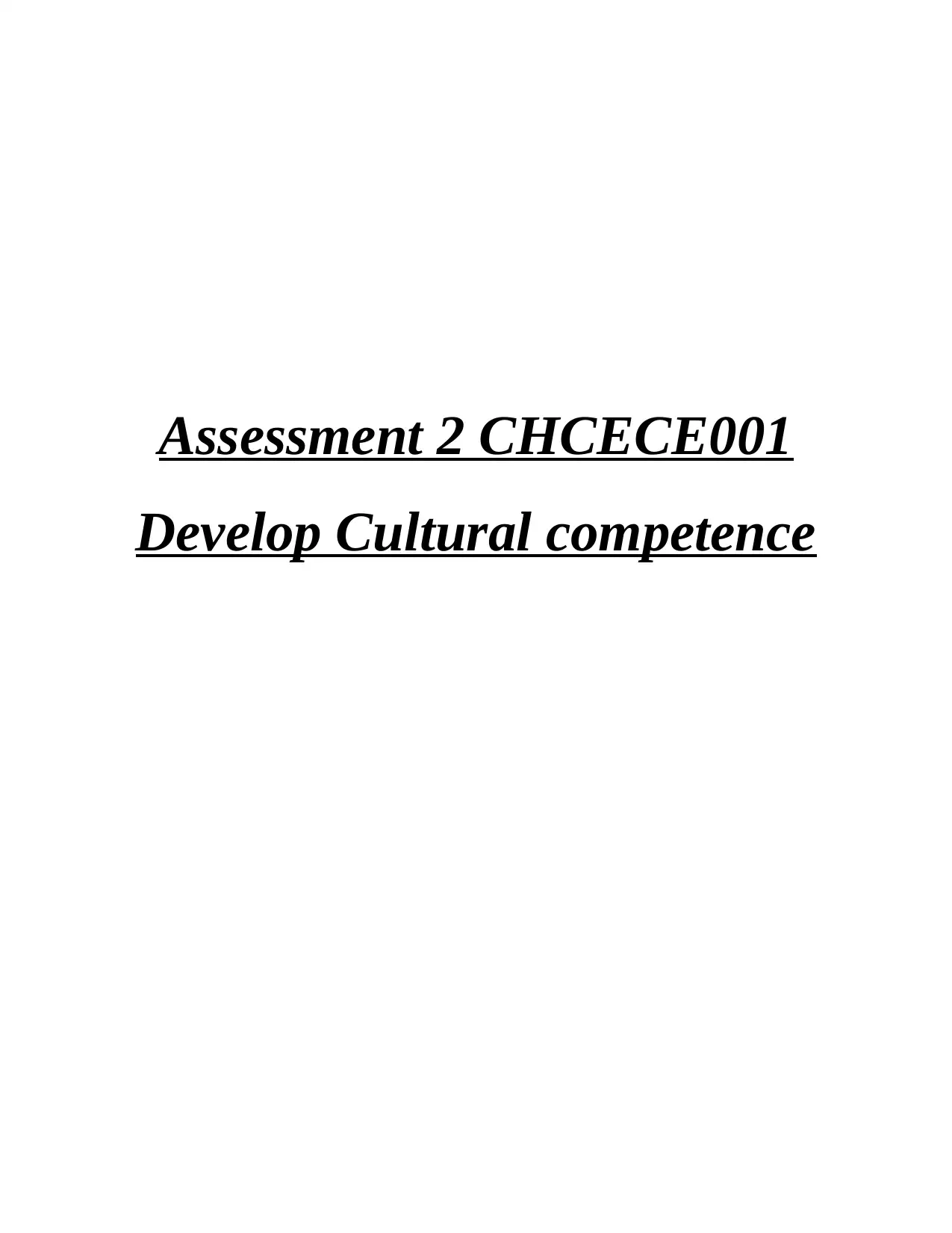
Assessment 2 CHCECE001
Develop Cultural competence
Develop Cultural competence
Paraphrase This Document
Need a fresh take? Get an instant paraphrase of this document with our AI Paraphraser
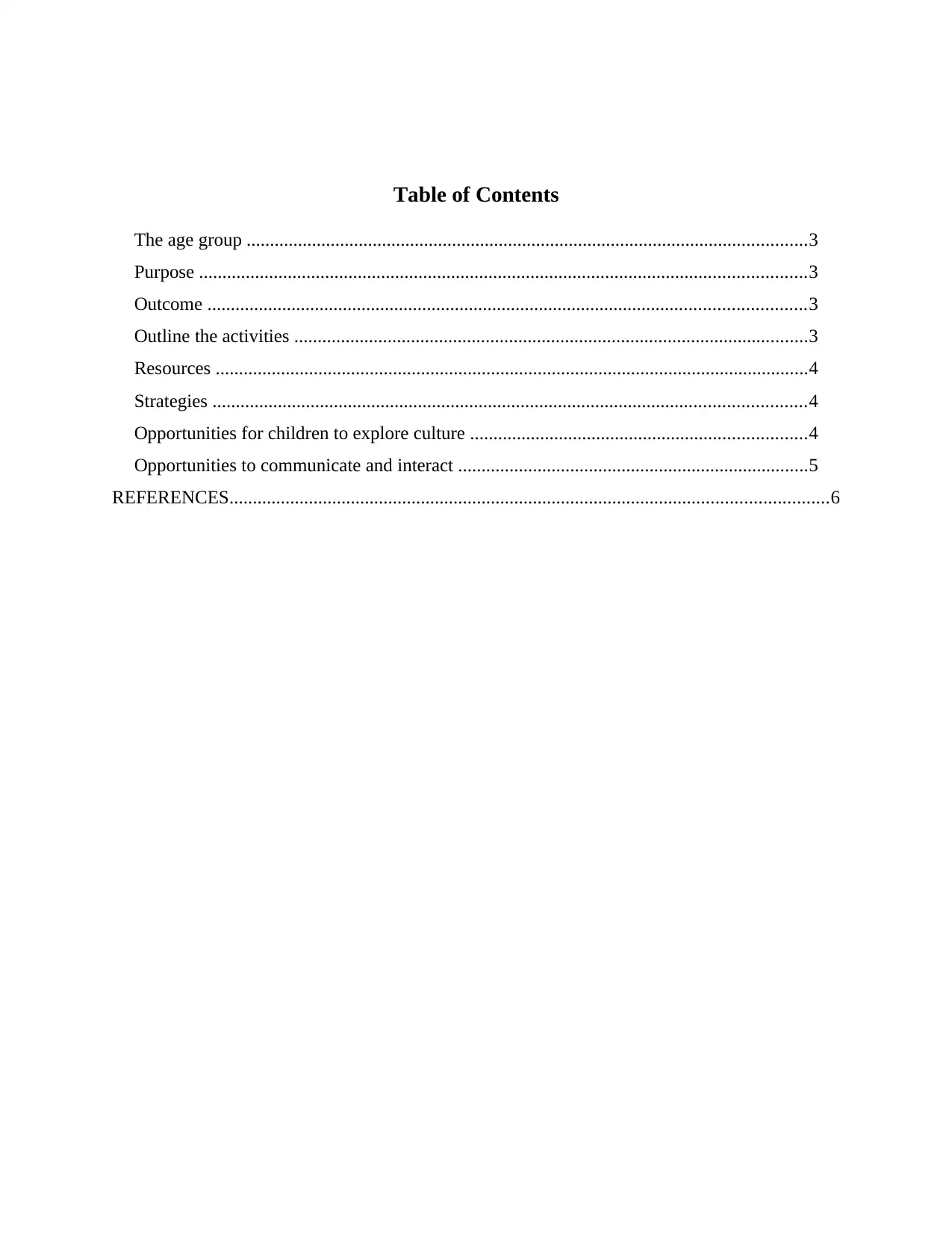
Table of Contents
The age group ........................................................................................................................3
Purpose ..................................................................................................................................3
Outcome ................................................................................................................................3
Outline the activities ..............................................................................................................3
Resources ...............................................................................................................................4
Strategies ...............................................................................................................................4
Opportunities for children to explore culture ........................................................................4
Opportunities to communicate and interact ...........................................................................5
REFERENCES................................................................................................................................6
The age group ........................................................................................................................3
Purpose ..................................................................................................................................3
Outcome ................................................................................................................................3
Outline the activities ..............................................................................................................3
Resources ...............................................................................................................................4
Strategies ...............................................................................................................................4
Opportunities for children to explore culture ........................................................................4
Opportunities to communicate and interact ...........................................................................5
REFERENCES................................................................................................................................6
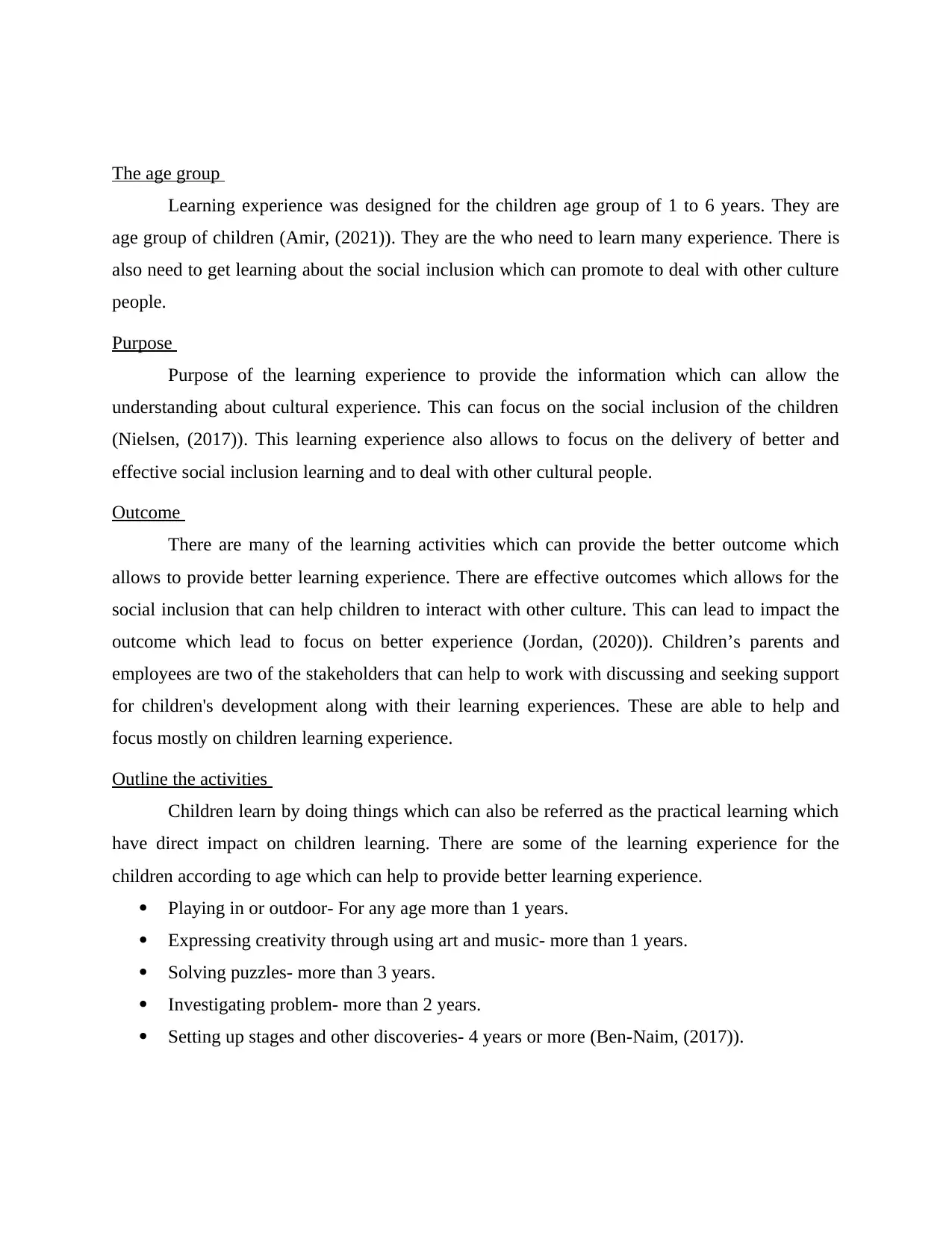
The age group
Learning experience was designed for the children age group of 1 to 6 years. They are
age group of children (Amir, (2021)). They are the who need to learn many experience. There is
also need to get learning about the social inclusion which can promote to deal with other culture
people.
Purpose
Purpose of the learning experience to provide the information which can allow the
understanding about cultural experience. This can focus on the social inclusion of the children
(Nielsen, (2017)). This learning experience also allows to focus on the delivery of better and
effective social inclusion learning and to deal with other cultural people.
Outcome
There are many of the learning activities which can provide the better outcome which
allows to provide better learning experience. There are effective outcomes which allows for the
social inclusion that can help children to interact with other culture. This can lead to impact the
outcome which lead to focus on better experience (Jordan, (2020)). Children’s parents and
employees are two of the stakeholders that can help to work with discussing and seeking support
for children's development along with their learning experiences. These are able to help and
focus mostly on children learning experience.
Outline the activities
Children learn by doing things which can also be referred as the practical learning which
have direct impact on children learning. There are some of the learning experience for the
children according to age which can help to provide better learning experience.
Playing in or outdoor- For any age more than 1 years.
Expressing creativity through using art and music- more than 1 years.
Solving puzzles- more than 3 years.
Investigating problem- more than 2 years.
Setting up stages and other discoveries- 4 years or more (Ben-Naim, (2017)).
Learning experience was designed for the children age group of 1 to 6 years. They are
age group of children (Amir, (2021)). They are the who need to learn many experience. There is
also need to get learning about the social inclusion which can promote to deal with other culture
people.
Purpose
Purpose of the learning experience to provide the information which can allow the
understanding about cultural experience. This can focus on the social inclusion of the children
(Nielsen, (2017)). This learning experience also allows to focus on the delivery of better and
effective social inclusion learning and to deal with other cultural people.
Outcome
There are many of the learning activities which can provide the better outcome which
allows to provide better learning experience. There are effective outcomes which allows for the
social inclusion that can help children to interact with other culture. This can lead to impact the
outcome which lead to focus on better experience (Jordan, (2020)). Children’s parents and
employees are two of the stakeholders that can help to work with discussing and seeking support
for children's development along with their learning experiences. These are able to help and
focus mostly on children learning experience.
Outline the activities
Children learn by doing things which can also be referred as the practical learning which
have direct impact on children learning. There are some of the learning experience for the
children according to age which can help to provide better learning experience.
Playing in or outdoor- For any age more than 1 years.
Expressing creativity through using art and music- more than 1 years.
Solving puzzles- more than 3 years.
Investigating problem- more than 2 years.
Setting up stages and other discoveries- 4 years or more (Ben-Naim, (2017)).
⊘ This is a preview!⊘
Do you want full access?
Subscribe today to unlock all pages.

Trusted by 1+ million students worldwide
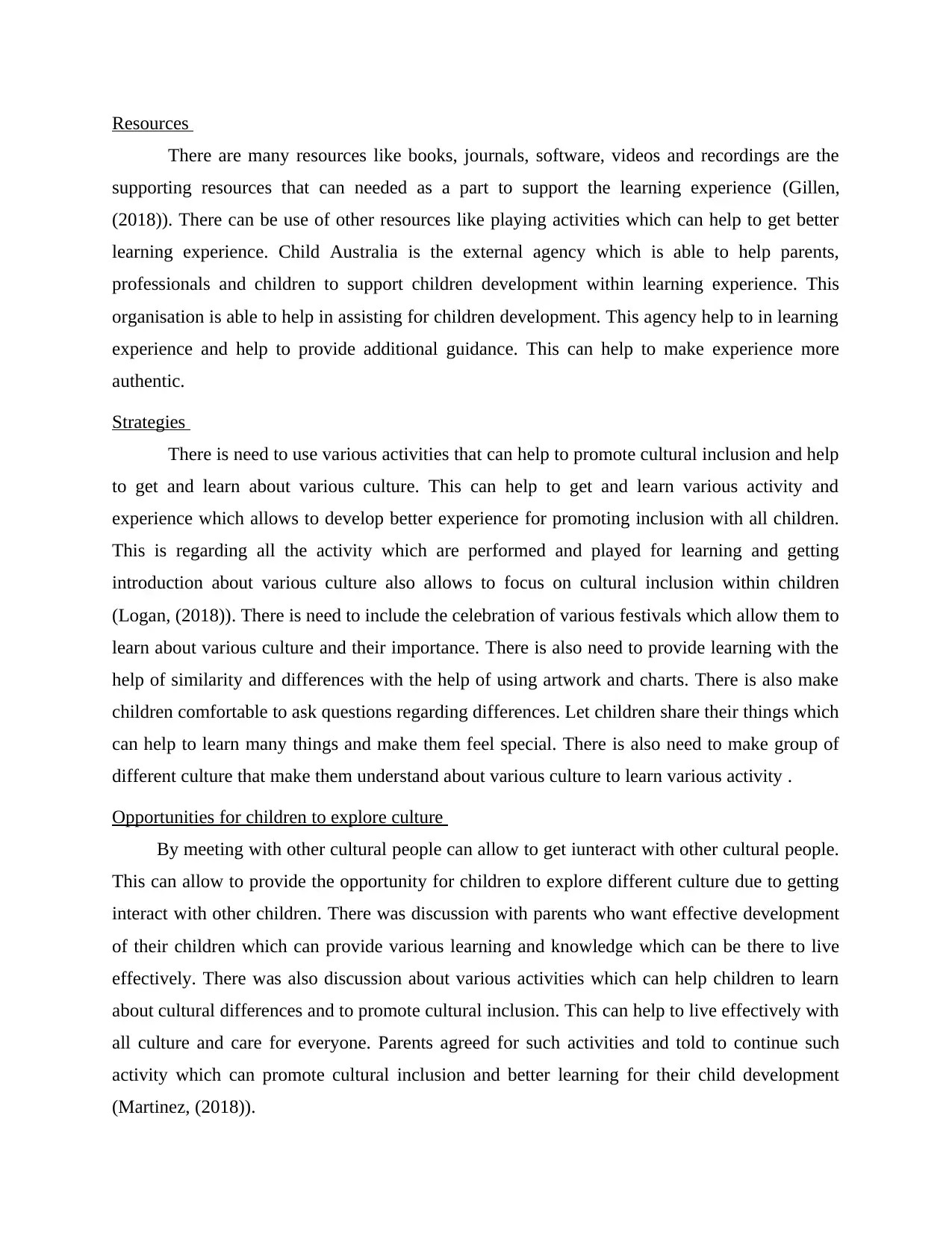
Resources
There are many resources like books, journals, software, videos and recordings are the
supporting resources that can needed as a part to support the learning experience (Gillen,
(2018)). There can be use of other resources like playing activities which can help to get better
learning experience. Child Australia is the external agency which is able to help parents,
professionals and children to support children development within learning experience. This
organisation is able to help in assisting for children development. This agency help to in learning
experience and help to provide additional guidance. This can help to make experience more
authentic.
Strategies
There is need to use various activities that can help to promote cultural inclusion and help
to get and learn about various culture. This can help to get and learn various activity and
experience which allows to develop better experience for promoting inclusion with all children.
This is regarding all the activity which are performed and played for learning and getting
introduction about various culture also allows to focus on cultural inclusion within children
(Logan, (2018)). There is need to include the celebration of various festivals which allow them to
learn about various culture and their importance. There is also need to provide learning with the
help of similarity and differences with the help of using artwork and charts. There is also make
children comfortable to ask questions regarding differences. Let children share their things which
can help to learn many things and make them feel special. There is also need to make group of
different culture that make them understand about various culture to learn various activity .
Opportunities for children to explore culture
By meeting with other cultural people can allow to get iunteract with other cultural people.
This can allow to provide the opportunity for children to explore different culture due to getting
interact with other children. There was discussion with parents who want effective development
of their children which can provide various learning and knowledge which can be there to live
effectively. There was also discussion about various activities which can help children to learn
about cultural differences and to promote cultural inclusion. This can help to live effectively with
all culture and care for everyone. Parents agreed for such activities and told to continue such
activity which can promote cultural inclusion and better learning for their child development
(Martinez, (2018)).
There are many resources like books, journals, software, videos and recordings are the
supporting resources that can needed as a part to support the learning experience (Gillen,
(2018)). There can be use of other resources like playing activities which can help to get better
learning experience. Child Australia is the external agency which is able to help parents,
professionals and children to support children development within learning experience. This
organisation is able to help in assisting for children development. This agency help to in learning
experience and help to provide additional guidance. This can help to make experience more
authentic.
Strategies
There is need to use various activities that can help to promote cultural inclusion and help
to get and learn about various culture. This can help to get and learn various activity and
experience which allows to develop better experience for promoting inclusion with all children.
This is regarding all the activity which are performed and played for learning and getting
introduction about various culture also allows to focus on cultural inclusion within children
(Logan, (2018)). There is need to include the celebration of various festivals which allow them to
learn about various culture and their importance. There is also need to provide learning with the
help of similarity and differences with the help of using artwork and charts. There is also make
children comfortable to ask questions regarding differences. Let children share their things which
can help to learn many things and make them feel special. There is also need to make group of
different culture that make them understand about various culture to learn various activity .
Opportunities for children to explore culture
By meeting with other cultural people can allow to get iunteract with other cultural people.
This can allow to provide the opportunity for children to explore different culture due to getting
interact with other children. There was discussion with parents who want effective development
of their children which can provide various learning and knowledge which can be there to live
effectively. There was also discussion about various activities which can help children to learn
about cultural differences and to promote cultural inclusion. This can help to live effectively with
all culture and care for everyone. Parents agreed for such activities and told to continue such
activity which can promote cultural inclusion and better learning for their child development
(Martinez, (2018)).
Paraphrase This Document
Need a fresh take? Get an instant paraphrase of this document with our AI Paraphraser

Opportunities to communicate and interact
There are many opportunities which can taken into consideration to communicate and
interact with other which can be during playing and performing other activities. By reviewing all
the feedback and advices which can help to make improvement in delivering of services for
better learning experience for children. These feedbacks and advice of stakeholders provide
information and to focus for the improvement in those area about which feedback or advice are
delivered (Nomaguchi, (2020)).
There are many opportunities which can taken into consideration to communicate and
interact with other which can be during playing and performing other activities. By reviewing all
the feedback and advices which can help to make improvement in delivering of services for
better learning experience for children. These feedbacks and advice of stakeholders provide
information and to focus for the improvement in those area about which feedback or advice are
delivered (Nomaguchi, (2020)).
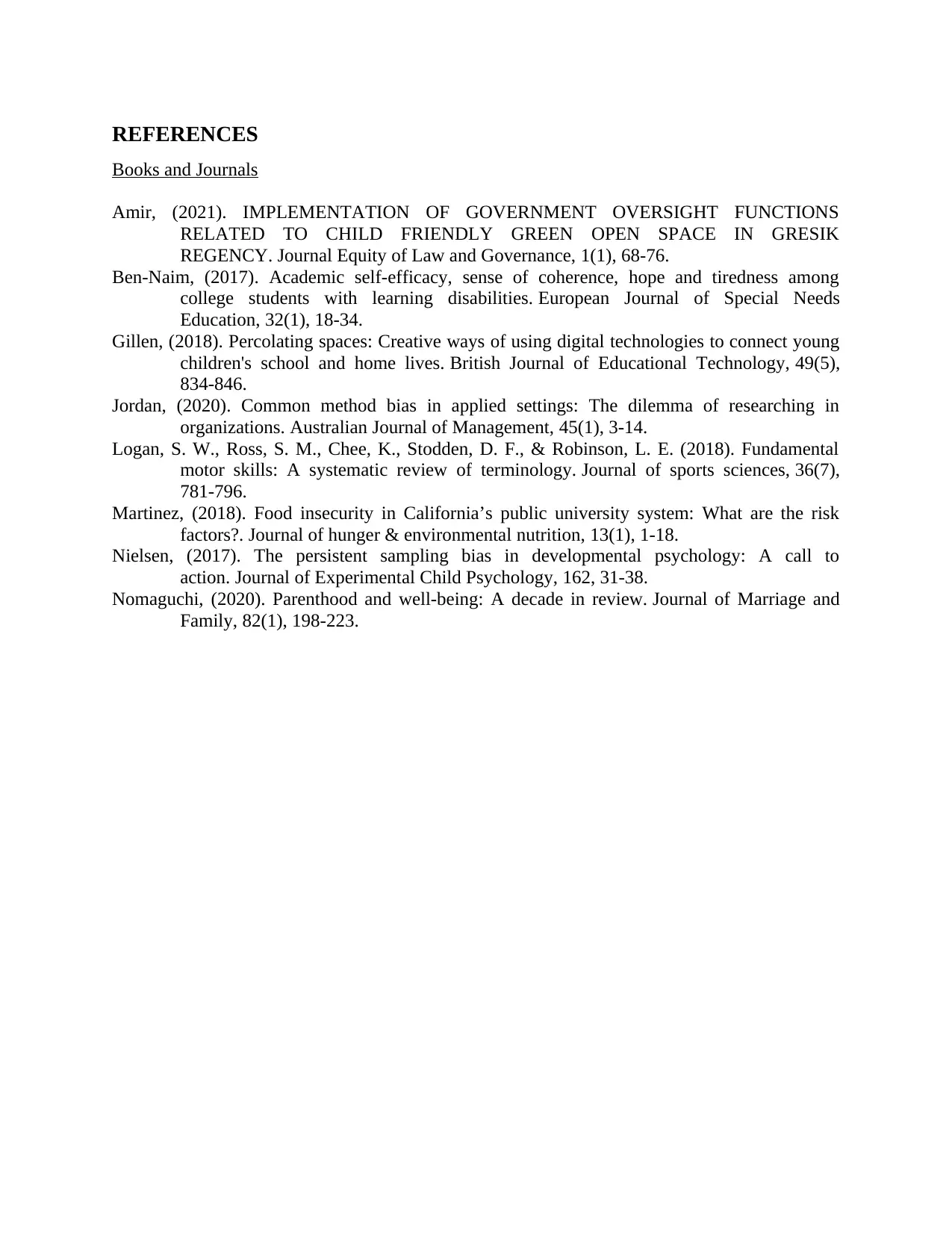
REFERENCES
Books and Journals
Amir, (2021). IMPLEMENTATION OF GOVERNMENT OVERSIGHT FUNCTIONS
RELATED TO CHILD FRIENDLY GREEN OPEN SPACE IN GRESIK
REGENCY. Journal Equity of Law and Governance, 1(1), 68-76.
Ben-Naim, (2017). Academic self-efficacy, sense of coherence, hope and tiredness among
college students with learning disabilities. European Journal of Special Needs
Education, 32(1), 18-34.
Gillen, (2018). Percolating spaces: Creative ways of using digital technologies to connect young
children's school and home lives. British Journal of Educational Technology, 49(5),
834-846.
Jordan, (2020). Common method bias in applied settings: The dilemma of researching in
organizations. Australian Journal of Management, 45(1), 3-14.
Logan, S. W., Ross, S. M., Chee, K., Stodden, D. F., & Robinson, L. E. (2018). Fundamental
motor skills: A systematic review of terminology. Journal of sports sciences, 36(7),
781-796.
Martinez, (2018). Food insecurity in California’s public university system: What are the risk
factors?. Journal of hunger & environmental nutrition, 13(1), 1-18.
Nielsen, (2017). The persistent sampling bias in developmental psychology: A call to
action. Journal of Experimental Child Psychology, 162, 31-38.
Nomaguchi, (2020). Parenthood and well‐being: A decade in review. Journal of Marriage and
Family, 82(1), 198-223.
Books and Journals
Amir, (2021). IMPLEMENTATION OF GOVERNMENT OVERSIGHT FUNCTIONS
RELATED TO CHILD FRIENDLY GREEN OPEN SPACE IN GRESIK
REGENCY. Journal Equity of Law and Governance, 1(1), 68-76.
Ben-Naim, (2017). Academic self-efficacy, sense of coherence, hope and tiredness among
college students with learning disabilities. European Journal of Special Needs
Education, 32(1), 18-34.
Gillen, (2018). Percolating spaces: Creative ways of using digital technologies to connect young
children's school and home lives. British Journal of Educational Technology, 49(5),
834-846.
Jordan, (2020). Common method bias in applied settings: The dilemma of researching in
organizations. Australian Journal of Management, 45(1), 3-14.
Logan, S. W., Ross, S. M., Chee, K., Stodden, D. F., & Robinson, L. E. (2018). Fundamental
motor skills: A systematic review of terminology. Journal of sports sciences, 36(7),
781-796.
Martinez, (2018). Food insecurity in California’s public university system: What are the risk
factors?. Journal of hunger & environmental nutrition, 13(1), 1-18.
Nielsen, (2017). The persistent sampling bias in developmental psychology: A call to
action. Journal of Experimental Child Psychology, 162, 31-38.
Nomaguchi, (2020). Parenthood and well‐being: A decade in review. Journal of Marriage and
Family, 82(1), 198-223.
⊘ This is a preview!⊘
Do you want full access?
Subscribe today to unlock all pages.

Trusted by 1+ million students worldwide
1 out of 6